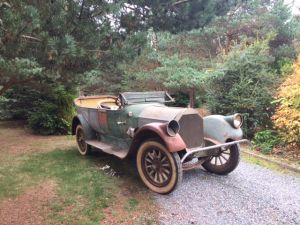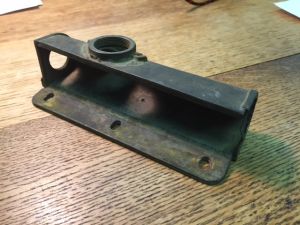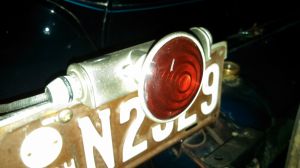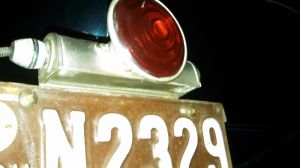- Home
- About Us
- Join/Renew
- Member Benefits
- Member Pages
- Log In
- Help
- Museum Store
Just brought home my next project. Its a 1918 Pierce 48 Series 4 Seven passenger touring. Very complete, authentic and unmolested minus upholstery and top. I’ll spend the winter going through the mechanicals and getting it on the road next summer. Any help or suggestions are welcome. I notice I am missing a tail light. Does anyone have a photo of the correct one……better yet, have one on the shelf you will sell me.

Congratulations on finding such a great car. They were “King of the
Road”” in their day and built to cheat the assault of time. If they
could only talk beyond the emotions they stir in those that experience
them. Are you going to share this one at Pebble Beach like you did with
your 1909 Pierce-Arrow Model 24T?”
Richard,
Looks like a worthy project. Good luck with and thank you for sharing.
Ken
Richard,
What a wonderful acquisition.
Peter
You found a great car to get back on the road.
They are great performers on the road and they are beautiful.
I had trouble keeping up with Ralph M’s when we toured in Oregon.
Good luck with the project and please post lots of pictures of your progress.
Tony……I don’t plan to do a total restoration on this car since it has so many original features. I want it to be a great driver and then tour it. I hope to preserve it as much as possible……it’s only original once.
I’ll throw photos up here now and then to show the progress……
Richard,
These cars will go faster than your brakes will allow.As for a tail iight,Tony Wollesen some years back made new ones and perhaps may have one left or be able to tool up and make one for you.He lives in San Jose,California and is a PAS member.
Mr. Scorah,
What you said is true of most two wheel brake systems. I have a
large 1910 auto that had the misfortune to have a wreck with a
police car in 1961. Back then they were able to locate a frame.
Hydraulic brakes with a power assist unit soon were put on her. The
moral of the story: The nut behind the wheel is the most important
item on a safe antique car, and brake upgrades are a wise investment.
Tony C.
Tony,
When I have driven my 1915 C-3 Pierce Arrow I have always found the brakes
to work just fine but in a residential area I would keep the car in lower gears and if on the open road stay at around 45 mph.My car is very original and would not want to change anything.I have driven modern cars with horrible brakes.I have driven Model T’s all over the place including up to Cripple Creek,Colorado and even up the Pikes Peak Road and never had any issues but I respected the technology.That I feel is the key.
Bill
Craig, it’s hard to hold them back. Great memories of Redmond, Oregon and the Modoc the week afterwards in our 1918 Roadster.
Richard,
I can get you a photo of the tail light but please give me the weekend.Do you have the Duplex cans and Kayes oil cans for your car? I have photos of these too.
Bill…..I could use photos of all of that. Any leads to finding any of this is also much appreciated.
Thanks,
Rich
Ralph, I thought I would be able to at least keep up with you but you eventually ran off and left us. 
Once we were doing around 65 -70mph I decided to not push it any further, I still have an all original motor and I didn’t want to test its limits.
The Redmond meet will always be one of great memories for us as well.
Love the car. I don’t think I would touch the cosmetics, too much fun to drive it the way it is. Probably the best pre 1920 platform you can buy, the 48 is the best of all worlds.
Yes……I plan to preserve the original paint, leather interior parts, etc. etc. I had someone at Hershey refer to the Series 4 48’s as ” the Iron Horse””……I’m looking forward to taking her down the road.”
Hi Richard, I had been told that the late teens right hand drive cars were the ‘peak’ of Pierce Arrow’s quality and engineering. When I heard that,, I didn’t think it was a valid statement..
But, having acquired a 1919 series 31, 38hp Dual Valve touring this summer, I’ve learned that the above statement does have a lot of validity. The car has an amazing amount of power, is quite capable of running 60mph, has very nice, precise steering, and is an amazingly solid mostly original car, , Every time I drive it, it impresses me again.
With the exception of the rear wheel only brakes, it is a car that runs and performs as well as many late twenties and early thirties cars. The rear wheel only brakes simply don’t have enough tire area touching the pavement to stop the car well on any type of road surface. If the road surface is wet, or is gravel or has limited traction, then a lot of caution and restraint is needed when applying a foot to the throttle.
Richard: you will really enjoy the 48hp car, Email me regarding what you need for your car,
Congratulations !!
G
An ancillary thought about the single rear light (tail + license light) used from about 1915 until the triple rear light (tail + stop + backing) introduced in 1924: There is only room in the housing for a small diameter globe such as a #63, which is only 3 candlepower (cp). That’s not much light being emitted to the rear. Upon acquiring my 1918 48-B-5 early this year, I looked at my 6V bulb collection in hopes of finding a brighter bulb that would fit within the housing. I happened upon #209 and #210 slightly-elongated 6V bulbs used for interior dome lights, each of which produces 15 cp, a substantial improvement. The globe diameter does not exceed that of a #63 bulb. Some of you may know that already–I didn’t.
Likewise, for the rare night driving experience, I have two clip-on bicycle lamps with red LED bulbs, operating on a single AAA battery, which offer the option of steady light or flashing. They are about $10 each at Walmart.
Thanks, all of this is helpful. I’m looking for parts for the tail light……does anyone have some of the parts that are missing that I might buy ? The photo shows that all I have is the body…..

Hi Richard, I went out and took a few pics of the light on my ’19.
The light has a thread-in reflector and lens assembly to thread into that large round boss on your light housing,
There is a piece of glass that covers the rectangular opening on the bottom roughly 1″x6″.
There is an end plate with a knurled knob holding the glass into the housing, preventing it from sliding out.
The light socket and wiring attachment go into the end of your housing with the round hole..
Here is the first of several photos.
Greg

Another image of the twilight.
Greg

